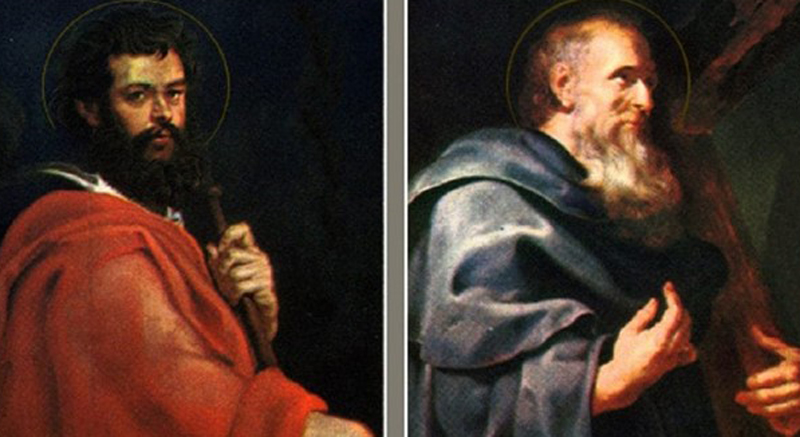Last Updated on April 29, 2022 by Editor
(1st century)
In the sixth century, the bodies of Sts. Philip and James were brought to Rome from the East and were laid to rest in the Basilica of the Holy Apostles. Since they arrived together at the same location, the Church instituted a single feast day for both apostles.
Previously, the Catholic Church had special feasts to honor only four of the apostles: Sts. Peter and Paul, St. John the Evangelist and St. Andrew, the brother of Peter. The Church memorialized the remaining apostles all together on June 29.
James often was referred to as “St. James the Less” to distinguish him from the other apostle named James, who was the brother of John. This nickname likely refers to his younger age, not that he was any less important. In fact, this James was referred to as “the brother of the Lord,” because his mother was related to the Blessed Virgin Mary.
It is said that James the Less looked so much like Jesus that even Mary sometimes confused the two. This story also states that James’ resemblance to Christ is the reason why Judas needed to identify Jesus with a kiss when he betrayed Him. We can reason that Christ was quite close with his cousin James because upon His Resurrection, He appeared to James personally before any other apostle (1 Cor 15:7).
St. James became the bishop of the Church in Jerusalem and played a central role in the Church’s first council (Acts 15). He confirmed the decision that the Gentiles need not undergo circumcision to follow Christ. In 62 A.D., the Jewish leaders accused James of breaking the Law and delivered him to the mob. He was taken to the top of the Temple and pressured to deny his claim, before all, that Jesus was the Messiah. James refused, and instead, he affirmed his belief that Jesus would return to judge the world on the Last Day. The Jewish leaders had him pushed off the battlements of the Temple. Though bruised by his fall, James garnered enough strength to kneel in prayer. As he begged God to forgive his executioners, they violently rained stones down upon him. He finally succumbed to death after someone struck him on the head with a club.
Philip was one of the first of the 12 apostles called by Christ. The day after Jesus called the first apostles, Peter and Andrew, He found Philip in Galilee. Unlike St. James the Less who remained a virgin, Philip was a married man and father to several daughters at the time of his calling. Philip was one of the first apostles to come to faith directly through Christ with no intermediary person. Simon Peter found the Lord through Andrew, and Nathanael was brought to the Lord by Philip, himself. Philip believed in Christ as soon as he encountered Him, after hearing only a couple of words.
So powerful was Philip’s newfound faith that he felt compelled to bring another into Christ’s fellowship, too. In response to Philip’s invitation, Nathanael responds, “Nazareth! Can anything good come from there?” This question prompts Philip to deliver one of his most memorable lines in Scripture, “Come and see” (Jn 1:46). Philip implies that to have faith in the Messiah, one must encounter Christ personally. Three days later, Philip joins some other apostles to attend the wedding at Cana and witnesses Christ’s first miracle, solidifying his faith in Christ.
Jesus tested Philip’s faith when he saw a great crowd and asked his Apostle, where they could buy bread for these people to eat. Philip answered him, “It would take more than half a year’s wages to buy enough bread for each one to have a bite!” But Jesus already knew what he would do, and he multiplied five loaves and two fish into enough food to feed five thousand men.
Philip also spoke during the Last Supper in the Gospel of John after Jesus says, “No one comes to the Father except through me. If you know me, you will know my Father as well. From now on, you do know him and have seen him.” To which Philip replies, “Lord, show us the Father, and that will be enough for us” (Jn 14:6-8).
Jesus answered, “Don’t you know me, Philip, even after I have been among you such a long time? Anyone who has seen me has seen the Father. How can you say, ‘Show us the Father’? Don’t you believe that I am in the Father and that the Father is in me?'” (Jn 14:9-10). Both of these examples in the Gospel of John prove that despite Philip’s initially quick ascent to faith in Christ, his faith remains feeble through most of the Gospel. But Philip’s example reminds us that God can use us effectively in spite of our weaknesses.
Philip also was martyred for his faith. After preaching with Bartholomew in Greece, he was scourged, imprisoned, and ultimately crucified upside down in 62 A.D.
Adapted by A.J. Valentini from: Feast of Sts. Philip and James – May 3. (2019, September 5). The Divine Mercy. https://www.thedivinemercy.org/articles/feast-sts-philip-and-james-%C2%A0may-3
